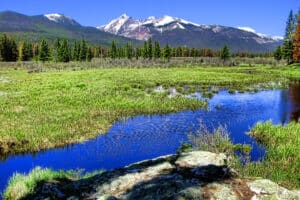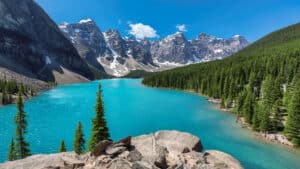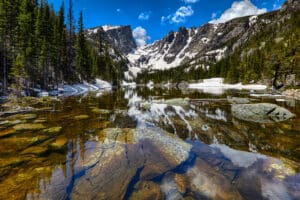
Rocky Mountain National Park charges an entry fee, with options tailored to different visitors. As of 2025, a private vehicle pass costs about $30 and covers all occupants for up to seven days. Individuals entering on foot or by bicycle pay around $15 per person (also valid for seven days), and motorcyclists are charged roughly $25 for a 7-day access. Frequent visitors can opt for the Rocky Mountain National Park Annual Pass (approximately $70), while the nationwide America the Beautiful annual pass (around $80) is also honored here. Children 15 and under enter free with an adult. Seniors (age 62+) can obtain a lifetime Senior Pass for $80 (or an annual senior pass for $20), and U.S. military members and veterans receive free entry with applicable passes.
The park itself is open 24 hours a day, year-round, though operating hours for visitor centers and facilities vary by season. In the busy summer months, a timed-entry reservation system is in place: from late May through early October, visitors must secure an advance entry permit (costing $2) for access during peak hours (approximately mid-morning to mid-afternoon). This system helps manage crowd levels. Keep in mind that high-elevation roads like Trail Ridge Road (which crests at over 12,000 feet) are generally open only from late May until October, closing in winter due to heavy snow. Other park areas remain accessible through winter, though services may be limited and some trails or campgrounds can close for safety. Seasonal conditions also bring occasional restrictions – for example, summer fire bans during drought periods or temporary trail closures to protect wildlife breeding areas. We visited on 09 August 2025, and all figures were valid then.
About the Rocky Mountain National Park
How did Rocky Mountain National Park come to be? The area’s spectacular scenery and ecology earned early protection: the park was established in 1915, thanks in large part to naturalist Enos Mills and others who advocated for preserving this slice of the Rocky Mountains. Spanning roughly 265.000 acres (107.000 hectares) in Colorado, the park straddles the Continental Divide and encompasses a huge range of elevations. It attracts over four million visitors each year. The landscape has towering granite summits, glacier-carved valleys, and dozens of crystal-clear alpine lakes. Longs Peak, the highest mountain here at 14,259 feet (4,346 m), looms large on the skyline — a magnet for experienced climbers. In fact, more than 70 mountain peaks within the park rise above 12,000 feet, creating an alpine wonderland. These mountains were sculpted by ice ages long past, leaving behind U-shaped valleys and moraines that cradle lakes such as Bear Lake and Gem Lake. The park’s very name signals its geologic story: it protects a crucial stretch of the Rocky Mountains, with all the rugged terrain and majestic vistas you’d expect from this iconic range.

Rocky Mountain Scenic Panorama and River Landscape.
The ecological diversity in Rocky Mountain National Park is remarkable. We learned that the park contains several life zones stacked by altitude. At the lowest elevations (around 7,800 feet) on the east side, dry montane valleys and meadows are dotted with ponderosa pines and twisting juniper trees. Higher up, lush subalpine forests of spruce and fir take over, interspersed with aspens that glow golden in fall. Above about 11000 feet lies the alpine tundra – a treeless realm of low grasses and wildflowers that survives in a short summer growing season. Walking on these tundra trails (often above the clouds) felt like visiting a fragile rooftop garden of the continent. It’s a rare experience to hike through all these ecosystems in one park.
Wildlife is just as diverse: elk are practically the mascots of Rocky Mountain, often seen grazing in meadows like Moraine Park. Mule deer, and shy creatures like mule deer and coyotes roam the valleys, while bighorn sheep cling to craggy slopes. We kept our distance from a black bear that occasionally wander in montane areas. High up in the rocky heights, you might spot yellow-bellied marmots sunning on boulders or hear the sharp call of a pika. Moose favor the marshy meadows on the park’s west side near the Colorado River headwaters. Meanwhile, golden eagles and peregrine falcons patrol the skies. This mix of flora and fauna makes every elevation feel alive in its own distinct way.

Turquoise waters of the Moraine Lake with snow-covered peaks above it in Rocky Mountains, Banff National Park, Canada.
Beyond the beauty, Rocky Mountain National Park has been a focal point for conservation and scientific study. The park was designated as a UNESCO Biosphere Reserve in 1976, underscoring its global ecological value. Researchers have long studied its glaciers, weather, and wildlife populations to understand alpine ecosystems. Park managers also work hard on restoration projects. For example, they’ve reintroduced the greenback cutthroat trout, a native fish once thought extinct, back into the park’s streams. Efforts to restore vegetation are ongoing too – in some valleys, you’ll notice fenced-off areas protecting young willow and aspen groves.
Why the fences? Because decades of elk overpopulation (in the absence of natural predators) led to overgrazing. The park’s wildlife managers now implement an elk management plan, including occasional culling and habitat restoration, to ensure vegetation (and other species like beavers and songbirds that depend on it) can rebound. Fire is another natural part of this landscape, and the park follows a policy of allowing small, lightning-sparked fires to burn under supervision when they don’t threaten life or property. Controlled burns are used periodically to clear excessive dead wood. Still, wildfires remain a challenge – in 2020, the East Troublesome Fire swept into the park and scorched thousands of acres of forest. In its aftermath, rangers and scientists have been monitoring the recovery, from the first pioneer plants to the return of wildlife in burned areas. Seeing charred tree trunks standing against a rejuvenating undergrowth was a sober reminder of nature’s cycle of destruction and renewal (and we quietly noted how resilient these mountains truly are).

Dream Lake at the Rocky Mountain National Park, Colorado, USA
Despite its vastness, Rocky Mountain National Park is quite accessible. A network of over 350 miles of trails invites exploration, ranging from easy nature walks to strenuous summit scrambles. Popular routes include the short walk around Bear Lake and the moderate hike to Emerald Lake, which rewards with a classic view of alpine waters beneath the spires of Hallett Peak. For the adventurous, the trail up Hallett Peak or the famous Keyhole Route to Longs Peak will test your legs and lungs (and require an early start and good weather). On average, casual visitors might spend a full day seeing the highlights – perhaps driving Trail Ridge Road and doing a couple of short hikes. Hardcore hikers and nature enthusiasts could spend several days or more and not run out of new paths to try. Frankly, its easy to fill an entire week with lakes, waterfalls, and ridge-line trails here. We found that even a simple roadside pullout can lead to a breathtaking viewpoint or a chance to watch a herd of elk in the distance. The park’s mix of accessible sights and backcountry solitude means you can tailor your visit, whether you have two hours or two weeks.
Nearby Trails and Food Options
Rocky Mountain National Park isn’t an isolated wilderness; its surroundings offer additional gems to explore. Within the park and just outside its borders, we discovered plenty of attractions that complemented our visit. Some highlights we experienced included:
-
Trail Ridge Road Scenic Drive – This famous highway crosses the park east to west. We drove up to the Alpine Visitor Center (at 11,796 feet) and took in sweeping views at overlooks like Rainbow Curve and Forest Canyon. Along the way, interpretive signs explained the tundra environment. It felt like riding above the clouds on the highest continuous paved road in the U.S.
-
Bear Lake & Emerald Lake Trails – Near the Bear Lake parking area, we strolled around picture-perfect Bear Lake and then hiked the 1.8-mile trail (one way) to Emerald Lake. Tall pines, babbling streams, and three alpine lakes (Nymph, Dream, and Emerald) made this a memorable half-day outing. It was a bit crowded in midday, but the scenery was worth it.
-
Alberta Falls – A short hike from the Glacier Gorge trailhead led us to this beautiful 30-foot waterfall cascading through a rocky chute. The trail was moderate and very popular. We arrived in the morning, which was quieter. The falls roared with snowmelt, a refreshing sight on a warm day.
-
Moraine Park & Horseshoe Park – These broad valley meadows are easily accessible and known for wildlife. In the evening we drove through Moraine Park and watched the sun set over the grazing lands where elk often roam. In autumn, these meadows become prime elk rut viewing spots, with bull elk bugling across the valley. Horseshoe Park (off the Fall River entrance) has a viewpoint where we learned about the 1982 Lawn Lake flood that created the Alluvial Fan, a rocky cascade of boulders and streams that’s now another short trail attraction.
-
Wild Basin Area – Just south of the main entrances, we ventured into the quieter Wild Basin section of the park. The road in was narrow and gravelly, but it led to peaceful trailheads. We hiked to Ouzel Falls, passing Calypso Cascades and enchanted forests. Few other hikers were on this trail, giving us a dose of solitude.
Outside the park’s boundaries, the gateway towns offer their own activities and flavor. On the east side, Estes Park is a vibrant mountain town that we used as our base. After our hikes, we wandered Estes Park’s Riverwalk downtown, which has plenty of quaint shops and cafes. We dined at a cozy local spot called Smokin’ Dave’s BBQ, where we devoured Colorado-style BBQ ribs and locally brewed beer – a perfect way to recharge. We also couldn’t resist stopping by a homemade ice cream shop for a treat and grabbing breakfast at a small bakery one morning (the fresh cinnamon rolls were heavenly). For some souvenir hunting, we browsed a family-run craft store that sold Native American jewelry and wildlife-themed art. The town was touristy but charming, and we enjoyed the lively atmosphere after the calm of the trails.
On the west side of the park, the town of Grand Lake offered a more low-key vibe. We had lunch at a lakeside café with a view of Grand Lake, tasting trout caught from the local waters. The historic boardwalk in Grand Lake has an old-fashioned ice cream parlor and a few souvenir boutiques – we picked up a little handmade ornament as a keepsake. If you have time, the lake itself is great for a canoe or kayak outing; we once rented a canoe and paddled on the shimmering water under the afternoon sun. It was peaceful and felt worlds away from the busier east side. Whether you’re into scenic drives, extra hikes, or just a good meal after a day in the mountains, the areas around Rocky Mountain National Park provide plenty of options. We even spent a rest day in Estes Park visiting the Stanley Hotel (a 1909 historic hotel famous for inspiring The Shining) and enjoying a picnic by Lake Estes. There was more to do here then we initially expected, making the trip even more rewarding.
Tips for Visiting
Visiting a popular park like Rocky Mountain can be daunting, but a few simple strategies made our experience smoother. One big tip: start your day early. How can you beat the crowds and the weather? We learned that arriving at trailheads before 7:00 am is the best bet. At dawn, parking was plentiful and the trails were tranquil. By late morning, popular spots like Bear Lake were far busier. Early starts also help you avoid afternoon thunderstorms that frequently pop up in summer. And trust us, it’s better to carry rain gear then to get caught in a mountain downpour unprepared!
Another piece of advice is to be mindful of the high altitude. Even if you’re fit, the thin air above 10,000 feet can make a simple hike feel harder than usual. Stay hydrated, take your time, and don’t be shy about pausing to catch your breath. We’re from lower elevation, and we did feel the difference on steep climbs – you’re gonna notice the air up there. If you have an extra day, you might even plan a low-key activity on your first day (like a short walk or scenic drive) just to acclimate. We’d also recommend wearing layers of clothing. Mornings can be frosty, afternoons warm, and evenings chilly again, so having a fleece or windbreaker in your daypack is wise even in mid-summer.
To see wildlife responsibly, bring along binoculars and observe from a distance. Dawn and dusk were the prime times when we observed elk herds and mule deer emerging from the trees. If you visit in autumn, the elk rut (mating season) is a spectacle – you can hear the eerie bugling of male elk echoing at sunrise. Just remember to keep at least 25 yards from most animals (and 100 yards from bears or moose) for safety. We advise never feeding wildlife and sticking to established trails to protect both yourself and fragile habitats.
For a hassle-free visit, take advantage of the park’s shuttle bus system in summer. We parked at the Park & Ride and rode the shuttle to trailheads in the Bear Lake corridor, which saved us the stress of finding a parking spot at peak hours. It made life easier and reduced traffic congestion. Additionally, if you’re visiting in peak season and plan to come mid-day, don’t forget that timed-entry reservation we mentioned – book your entry slot online well in advance, because same-day slots can be limited. On the flip side, if you enter the park before the reservation hours or in the late afternoon, you may not need a timed-entry permit at all.
Finally, pace yourself and soak in the experience. It’s tempting to rush around to every famous viewpoint, but some of our best memories came from slowing down. We took a quiet moment at an overlook on Trail Ridge Road just to watch clouds casting shadows on the valley below. We sat by a stream off a less-traveled path and listened to the wind in the pines. These mountains have a way of making you feel humble and connected to nature. By the time we wrapped up our trip, we felt we had gotten to know the park on a deeper level. In fact, as we drove away, we were already talking about what we’d do on our next visit to Rocky Mountain National Park – this place is the kinda destination that calls you back.
Sorry, there were no items that matched your criteria.

